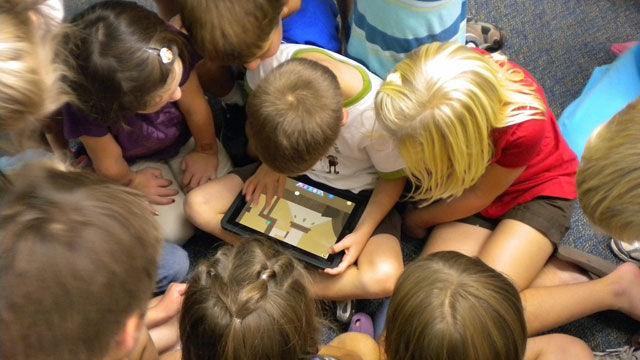“It all starts connecting,” Gilbert said. “When you get into the game it all connects to the state standards.” For example, if students build monuments in the game, they’re using math skills but also thinking about the artistic relevance of such a symbol. “You as the teacher need to know what your goal is for them, and then set them up so they can succeed,” Gilbert said. “If you have a good enough game, they’re going to gain more knowledge than you expect.”
Sandbox games are Gilbert’s favorites -- there are lots of ways to win or lose, and students get to show off their creativity and critical thinking. He also thinks commercial games are some of the best tools because of their rich graphics and strong game mechanics. "Civilization IV" is sometimes criticized for not being historically accurate, but Gilbert sees that flaw as a teachable moment. “You can turn the things that might not be necessarily correct into learning experiences,” he said.
Gilbert points out that the hardest part of any teacher’s job is reaching a variety of learners, all at different stages of development and academic skill. He’s noticed that while not all his students love playing video games for class, struggling learners often come out of their shells and prove they can deliver some of the most innovative solutions. Succeeding in one area of class helps them gain confidence for other tasks, like writing and group projects.
This anecdotal observation bears out in the Cooney Center research, which found that 55 percent of teachers who use digital games report they are a good tool for motivating low-performing students. Teachers see that motivation translating into academic performance. too: 78 percent of teachers using digital games saw improved performance on curricular subjects due to gameplay, and 71 percent saw improvement in extracurricular subjects.
Like many other teachers, Gilbert says it can be hard to integrate games into the curriculum when the focus is overwhelmingly on standards and state tests. “Things are becoming more regimented in the classroom,” he said. He understands that many teachers don’t have time to rework their whole curriculum to include games, especially if they themselves aren’t comfortable with digital gameplay.
GAMIFYING CLASS
Students in Caryn Swark’s Grade 6 class (she teaches in Alberta, Canada) come to school and immediately find themselves immersed in a fictional world where the king has been kidnapped and they must rescue him. Students have avatars and “level up” throughout the year as they master different skills. This gamified environment is part of the class DNA, so it’s no surprise that Swark is also using digital games to help students engage and connect with the material she’s teaching.
“There’s a lot of games that are basically worksheets in disguise,” Swark said. “I try to avoid those games as much as possible. They’re not really games and kids aren’t stupid.” Like Gilbert, Swark believes there are lots of educational merits to some commercial games, especially if teachers think expansively about how to build on game narratives and skills.
Swark uses Nintendo DS games like "Professor Layton and the Curious Village," a game that is basically like reading a novel embedded with math problems and puzzles. The first time she played it, Swark was struck by how similar some of the puzzles were to things she had asked students on worksheets. When kids play the game, they are doing lots of reading and math, but they like it.
Similarly, "Prodigy," a commercial math computer game, is built around a wizarding world where students do battle by solving math problems. Swark wishes the math were a little more integrated, but students still find the game fun and engaging.
“Instead of thinking about a checklist of curricular needs that I have to meet, I think about how this fits into what I need,” Swark said. She has found that not only are kids more interested in what they’re learning through gameplay, but they stick with tricky problems longer, work together better and are more open to trying over and over again. The stakes are lower when a student fails within the game, and she doesn’t see any of the test anxiety that has begun to plague her students.
“Framing things in terms of gameplay helps get through blocks for kids who get to Grade 6 and are already convinced that they can’t learn,” Swark said. She’s seen her weaker students gravitate toward gameplay and make significant gains. Games are one part of her yearlong goals to break students of the notion that they will fail even when they try.
As a female teacher and a “gamer,” Swark has often found bringing games into the classroom helps her connect more to her male students. And students who are alienated socially have become popular because of their abilities to help others in games like "Minecraft."
Swark got inspired to try games in her classroom after reading Lee Sheldon’s book, The Multiplayer Classroom: Designing Coursework as a Game, and jumped in feet first. She’s built on her success and retooled her failures, just as she’s asking her students to do with their schoolwork. Parents and administrators have been more supportive than she expected -- she’s even suggested parents expose their struggling readers to fan fiction to get them reading.
But not all teachers work in such supportive environments. In those cases, or when an educator is more hesitant, Swark recommends teachers check out game-rating sites like "Graphite," run by the nonprofit Common Sense Media, to choose games that clearly align with the grade and standards they teach. She also says it’s easier to start with overtly educational games and work up to the more open-ended games. Lastly, she says there’s a lot to learn from other educators.


